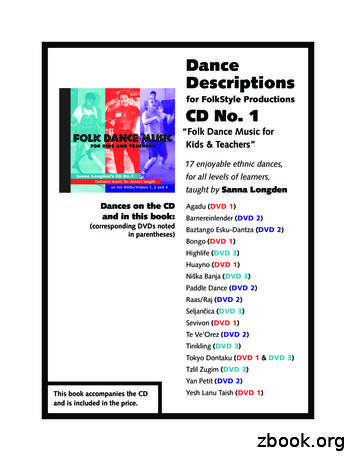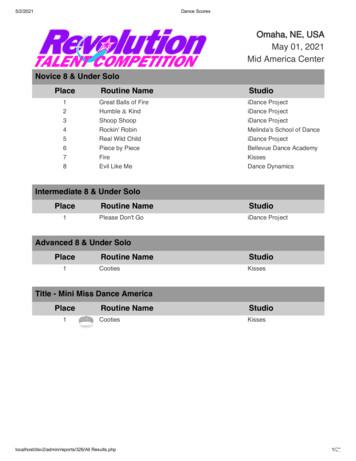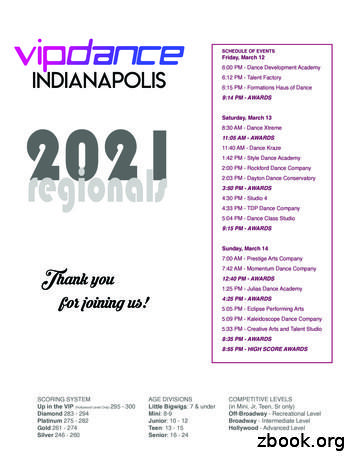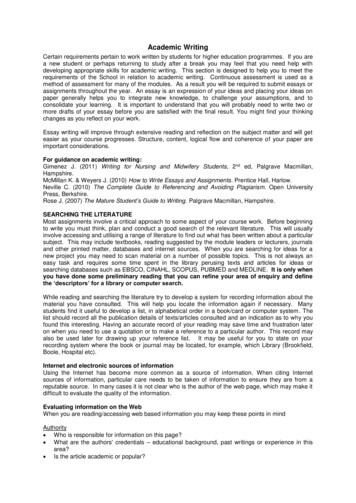Department Of THEATER & DANCE - Colby College
Department of THEATER & DANCEOffice of the TECHNICAL DIRECTORTech Theater Termsfile last updated: 7.29.2010 (JDE)All information contained in this document is original material copyright 2005 by John D. Ervin and isintended for the use of my students. Please contact me at jdervin@colby.edu for permission to use thismaterial in any other way. This is a work-in-progress and will be occasionally appended.Apron – The portion of the stage or playing space that is downstage of the proscenium arch. Intraditional proscenium-style theaters, acting on the apron was a big “no-no” because it violated thestage picture being created by the proscenium arch. Thus many older theaters have very shallowaprons. Nowadays though, Directors can’t get enough of having their actors as close to the audienceas possible; despite how uncomfortable it makes some audience members. This is all done underthe umbrella of ‘intimacy’ and we all know how much artists love that stuff. Sometimes the apron isreferred to as the “Forestage”. (See Figure 1 and 2)Arbor – Part of a fly system. A device mounted in one of the wings, which is connected to the lift lines atthe opposite end from the batten. Stage weights are stacked on the arbor to balance the loadsuspended from the batten. In the case of a counterweight fly system, a rope hand line is connectedto the top of the arbor, passes sequentially through the head block and tension block, and isterminated to the bottom of the arbor, forming a loop. This allows an operator to pull the rope andcause the batten to raise or lower. Arbors are guided either by steel tracks or wire ropes (aircraftcable).Backdrop – Also known as a “Drop”. A large curtain, which hangs upstage and hides the back wall ofthe theater from the audience. Backdrops are painted to resemble some sort of scene or abstractimage. Backdrops are often used in place of a blackdrop when the blacks are being used.Relevant Web Site: Tobins Lake Studios http://www.tobinslake.com (Note: I have not received any money for including this link,however, if anyone wants to send me some cash )Batten – Part of a fly system. A horizontal pipe, supported by lift lines, which is easily raised andlowered; even while holding a substantial amount of weight.Beam – The name for a particular place where lighting units are hung in a theater. A beam is a horizontalpipe hanging downstage of the proscenium. It gets its name from the many theater buildings thathide the beam pipe in a piece of architecture that, while fake, looks like something which is supportingthe ceiling. Beams are numbered on a light plot consecutively beginning with the pipe closest to theproscenium arch. (Sample sentence: “Hang this unit on the second beam FOH.”) See also “Boom”,“Box Boom”, and “Electric”.Black Traveler – See “Traveler”Blackdrop – See “Blacks”.Blackout – Removing all light from the stage as quickly and suddenly as possible. See also “Fade toBlack”.Blacks – The blacks are a collection of stage drapery; usually made of black velour. These curtains hangon each side of the stage, above the stage, and upstage of the playing space for the purpose ofmasking the wings, flys, and upstage wall respectively. Blacks masking the flys are known as“Borders”. Blacks masking the wings are known as “Legs”. “Borders” are also referred to as“Teasers” and “Legs” are then called “Tormentors”. If you don’t want to come across as stupid whentalking to anal-retentive techies like myself, never mix these pairs. “Borders” go with “Legs” and“Teasers” go with “Tormentors”. Any other combination is considered very bad and might lead to theundoing of creation as we know it. The upstage curtain is known as a “Blackdrop”. Note that“Blackdrop” is spelled with an “L”. A “Backdrop” (no ”L”) is a completely different curtain. When acomplete set of blacks is hung, the audience should ideally not be able to see any backstage place.(See Figure 6)Boards or The Boards – See “Stage”.
John’s List of Tech Theater Termspage 2Boom – The name for a particular place where lighting units are hung in a theater. A boom is a verticalpipe standing anywhere onstage. Booms are numbered on a light plot consecutively in each direction(upstage or downstage) beginning with the pipe closest to the proscenium arch. (Sample sentence:“The dancer bent the shutter on the stage left boom #2 shin-buster.”) See also “Beam”, “Box Boom”,and “Electric”.Border – See “Blacks”.Box Boom – The name for a particular place where lighting units are hung in a theater. A box boom is avertical pipe standing downstage of the proscenium in any of the side-wall box seats (which is whereit gets its name from). Modern theaters that don’t have side-wall box seats, but do have vertical pipesmounted on the walls, also use this term. If, however, the pipe and lighting units are hidden behind anotch in the wall, the term “Cove” is more appropriate. Box booms are numbered on a light plotconsecutively beginning with the pipe closest to the proscenium arch. (Sample sentence: “Since theunits on the box booms are in full view of the audience, we had them plated in brass.”) See also“Beam”, “Boom”, and “Electric”.Box Set – A set with three walls (one upstage and one on each side of the stage) and sometimes aceiling or any set which fairly closely resembles this description. Box sets are almost always interiors;usually a home. A true box set looks like an oversized shoe-box diorama.Center Line – A special type of line drawn on a Ground Plan, located at the plane which bisects thestage left and stage right sides of the theater. It is a relatively thin line made up of a repeating patternof: long dash, short space, short dash, short space, long dash, etc. and has the letters “C” and “L”overlapping each other at both ends of the line. For dimensioning purposes, the Center Line is akinto the “Y” axis on a graph. See also “Plaster Line”.Center Line Section – A two-dimensional drawing of the scenery as it relates to the theater’sarchitecture. A Center Line Section is drawn in measured scale and represents the view of the setfrom either wing. Because the view from the wings would likely be obscured by masking (and a lot ofperformers standing around), a convention is established where only the objects on the opposite sideof the Center Line are drawn. This convention is referred to as the “Cutting Plane”. For most sets,the cutting plane is at the Center Line unless indicated otherwise (and if so, the drawing title simplybecomes “Section”). This means that all objects on the same side of the stage as the draftsperson –including set pieces – are either not drawn or shown as a dashed line (known as a hidden line). Forthis reason, sometimes a more than one Center Line Section is drawn from opposing vantage points.A Center Line Section is best for finding out information about the height of set pieces, theirrelationship to sightlines (especially in the case of a theater with one or more balconies), and theelevated locations of various set pieces and lighting instruments. Ironically, Center Line Sections tellus almost nothing about the relation of any given object to the Center Line. See also “Ground Plan”.Color Scroller – See “Scroller”.Counterweight Fly System – See “Fly System”.Cove – See “Box Boom”.Cross Fade – Using a light board to change the look of the lights onstage from one appearance toanother. (E.g. A bright sunny day becomes a clear night.) A well designed and executed cross fadelooks almost like the light is dissolving from one look to the next.Crossover – The upstage place behind any stage curtains or scenery, which allows performers to getfrom one side of the stage to the other without being seen by the audience.Cue – Any moment in the course of a performance, where there is a change in the physical state. In thecase of sound, a cue might start music playing, and then a subsequent cue might lower the volumeas an actor starts to speak, and yet another might fade the music to silence when the scene comes toan end. Cues are most often associated with lighting and sound (any given show quite often hashundreds of light and sound cues), but cues are also established when scenery needs to change, linesets need to fly, effects need to be triggered, etc.Cutting Plane – An imaginary plane associated with mechanical drawings indicating what an objectwould look like if it were cut in half at that place.Cyc – See “Skydrop”.Cyclorama – See “Skydrop”.Deck or The Deck – See “Stage”.
John’s List of Tech Theater Termspage 3DMX or DMX512 – An internationally recognized standard or protocol, primarily intended for universalcommunication between lighting controllers and dimmers. DMX also allows for light boards andpersonal computers to send data commands to a virtually limitless bounty of lighting accessories suchas color scrollers, moving lights, and gobo rotators. Because of the worldwide acceptance of DMX,many other devices can be controlled via DMX. Again, the possibilities are mind-blowing, andexisting implementations include everything from DMX fog machines to my personal favorite, theDMX coffee pot.Dressing – Properties that aren’t necessarily handled or referred to by the performers; the minutiae of setdecorations that help communicate the locale of a set and complete the stage picture (E.g. posters,knick-knacks, fridge magnets, plants, rugs, etc. – and I do mean etc.!) See also “Props”.Drop – See “Backdrop”.Electric – The name for a particular place where lighting units are hung in a theater. An electric is ahorizontal pipe hanging upstage of the proscenium (usually part of the fly system). Electrics arenumbered on a light plot consecutively beginning with the pipe closest to the proscenium arch.(Sample sentence: “Line set #10 is the fifth electric.”) See also “Beam”, “Boom”, and “Box Boom”.Ellipsoidal Reflector Spotlight – A type of theatrical lighting unit that casts a relatively narrow, sharpedged beam of light. E.R.S.’s (as they are also referred to) are usually intended to be used furtheraway from the subject they are illuminating. The two most common types of lighting units in anygiven production are the Fresnel and the Ellipsoidal Reflector Spotlight.E.R.S. – See “Ellipsoidal Reflector Spotlight”.Fade to Black – Removing all light from the stage over a certain period of time. This is usually donesubtly to avoid jarring the audience; even in relatively quick Fade to Blacks. However, when the lightsare instantaneously put out, this is known as a “Blackout”.False Perspective – When scenery is made in unrealistic proportion to other pieces of scenery on thesame set. The smaller pieces of scenery are placed upstage of the larger ones. An example mightbe three telephone poles, each farther away from the audience than the previous (though I’m hardpressed to think of a single play that calls for such). In a non-false perspective set, the Designerwould draw one telephone pole and tell the shop to build three identical ones. However, in a falseperspective set, each telephone pole would be a unique size; even if they were identical looking. Tofurther understand this term, go take a course in perspective drawing, or at least look at the paintingsof Leonardo DaVinci (among others).Fire Curtain – A permanent feature of proscenium-style theaters; usually mandated by national or localfire and life safety codes. Fire curtains are located immediately upstage of the proscenium arch(downstage of the grand curtain) and are designed to automatically close and seal off the stage areafrom the rest of the house in the event of a fire. Some cities require that fire curtains be closed at alltimes except during the performance itself. If you go see theater in London, for instance, they evenclose the fire curtain during intermission (that’s “interval” for all you anglophiles).Flat – A relatively thin piece of scenery which is often joined with others, and can be used to create wallsand other vertical scenery. Flats are either soft-covered (meaning fabric stretched around a woodenframe; like a painting) or hard-covered (wood sheet-stock affixed to a wooden frame; and hopefullycovered in fabric as well, but an awful lot of short-changed, hard-covered flats exist out there )Hard-covered flats are sometimes called “Hollywood’s”. Hard-covered flats are best at recreatingrealistically solid walls and soft-covered flats are best if you want to keep the crew from complainingwhen they have to carry the set all over the place.Fly System – A series of pulleys, ropes, wires, and/or other apparatus which collectively allows thehanging and movement of curtains, lighting instruments, scenery, and even people. Most fly systemsby themselves have little more movement options than raising and lowering, but can become part of amore complicated system when a person or object is meant to have the appearance of actuallyfloating or flying. There are several types of fly systems. The most common are “Counterweight”,“Pin-and-Rail”, “Winch”, “Hydraulic”, and “Motorized”. See also “Arbor”, “Batten”, “Hand Line”, “HeadBlock”, “Lift Lines”, “Line Set”, “Loading Gallery”, “Lock Rail”, “Loft Block”, “Rope Lock”, “StageWeights”, and “Tension Block”.Flys – Yes, it’s spelled “flys” and not the more popular version associated with the plural form of a certainvariety of insect that I take great delight in squishing. This is the area above the performance space,upstage of the proscenium arch. Most proscenium-style theaters have a fly system and while it isoperated from one of the wings, the most useful part of the fly system appropriately lives in the flys.See also “Wings”. (See Figure 1, 2, and 3)FOH – See “House”.Forestage – See Apron.Front-of-House – See “House”.
John’s List of Tech Theater Termspage 4Fresnel – (pronounced Fruh-NELL) A type of theatrical lighting unit that casts a relatively wide, smoothbeam of light. Fresnels are usually intended to be used fairly close to the subject they areilluminating. The two most common types of lighting units in any given production are the Fresneland the Ellipsoidal Reflector Spotlight.Gobo or Pattern or Template – A thin piece of metal or glass typically inserted into an ellipsoidal reflectorspotlight or certain types of moving lights because of these unit’s abilities to project a clean, focusedimage onto a surface, much the same way a movie projector works. Metal gobos typically onlyproduce a silhouette image, but glass gobos have a full range of color and imaging possibilities.Grand Curtain – The curtain that closes just upstage of the proscenium arch. Grand curtains or the“Grand Drape” is often colorful and frequently ornate (lots of gold fringe, tassels, and so on). Theyusually look heavy and usually are heavy. Generally speaking, opening the grand curtain signifiesthe start of the show or act and closing it signifies the end of the act or show. Sometimes also calledthe “House Curtain”.Ground Plan – A two-dimensional drawing of the scenery as it relates to the theater’s architecture. AGround Plan is drawn in measured scale and represents the view of the set from above. Because theview from above (or birds-eye view) would be the roof of the building (and that’s pretty darn useless inthe shop), a convention is established where the roof and many other items are not drawn. Thisconvention is referred to as the “Cutting Plane”. On most ground plans, the cutting plane should beassumed to be 4’-0” above and horizontal to the stage floor, unless indicated otherwise. This meansthat all objects above this plane – including set pieces – are either not drawn or are shown as adashed line (known as a hidden line). A ground plan is best for finding the location of any object inrelation to the “Center Line” and “Plaster Line”. Ground plans tell us very little about the height ofmany set pieces, though some information is given. See also “Center Line Section”.Ground Row – A piece of scenery sitting on the floor upstage, which hides the bottom of a skydrop, cyc,or drop and creates the sense of a horizon with the sky beyond. A ground row can either be a smallneutral bit of vertical scenery, perhaps nothing more than a plank of lumber painted the color of thedeck, or as elaborate as a miniature cityscape or landscape.Relevant Online Images: As You Like It production stills tfolio/AYLI/01.htm Hand Line – Part of a counterweight fly system. The rope that an operator pulls to cause the raising orlowering of a batten.Head Block – Part of a fly system. A pulley with multiple sheaves or grooves, mounted in the wings, onthe grid or some other ceiling structure, through which passes all of the lift lines and (in the case of acounterweight fly system) a rope hand line.House – The place where the audience sits to watch the performance. Also the place where lightinginstruments hang when they’re hanging over the audience. Front-of-House can also refer to thelobby or other non-performance space where audience members congregate before and after theshow and during intermission. This can lead to much confusion, so if you’re asked how many lightingfixtures are hanging FOH, ask for clarification. Also referred to as “Front-of-House” or “FOH”(pronounced using the letters and not as the number four in Ebonics).Hydraulic Fly System – See “Fly System”.Jack – A device that is usually mounted out of sight of the audience and is always used to keep flats fromfalling over. Jacks can either be homemade or, if you have a small fortune, purchased fromprofessional manufacturers.Legs – See “Blacks”.Leko – Trade name for one particular manufacturer’s version of Ellipsoidal Reflector Spotlight. Using theword Leko is almost always a misnomer and kind of like saying Kleenex rather than tissue. The Lekohasn’t been manufactured in years, but the nickname still persists in common usage. See also“Ellipsoidal Reflector Spotlight”.Lift Lines – Part of a fly system. Wire, manila, or synthetic ropes from which a batten hangs.
John’s List of Tech Theater Termspage 5Light Plot – A two-dimensional drawing showing where all of the lights for any given show need to behung. Light Plots are drawn in measured scale and somewhat resemble the Ground Plan (with someartistic license taken in regards to the Cutting Plane, so that lighting units are never shown ashidden). The amount of information found on a Light Plot will vary from one drawing to the next, butat the minimum must include what type of instrument is to hang and where exactly it goes. Eachinstrument will also be given a number (referred to as either an instrument or unit number) that allowsfor additional information to be cross-referenced with other paperwork or computer programs. Thisnumbering scheme always reads from right to left on any given batten and from top to bottom on anygiven boom. Some Light Plots also include any combination of the following: where the unit will beaimed (focus area), what color the unit will be, notification of intended accessories (iris, gobo, top hat,barn door, scroller, etc.) the wattage of the lamp, the number of the circuit that the unit is pluggedinto, and the number of the controlling channel on the light board.Line Set – The collected components of any one line in a fly system. In the case of a counterweight flysystem, a line set is composed of a batten, multiple lift lines and loft blocks, a head block, an arbor, atension block, a hand line, and a rope lock.Loading Gallery – Part of a counterweight fly system. The catwalk or other platform located near thegrid in the wings on one side of the stage, for the purpose of allowing easy access to loading andunloading stage weights from arbors when line sets are fully flown in.Lock Rail – Part of a counterweight fly system. The piece of steel, in one of the wings, that holds all ofthe rope locks in a fly system.Loft Block – Part of a fly system. A pulley, mounted over the playing space, on the grid or some otherceiling structure, through which passes a lift
John’s List of Tech Theater Terms page 2 Boom – The name for a particular place where lighting un its are hung in a theater. A boom is a vertical pipe standing anywhere onstage. Booms are numbered on a light plot consecutively in each direction (upstage or downstage) beginning with the pipe closest to the proscenium arch. (Sample sentence:
From the following 14 events: Big Bang Dance Classic, Desert Dance, Line Dance Showdown, Xperience, Line Dance Marathon, Fun In The Sun, Ft Wayne Dance For All, Hotlanta, Palm Springs Line Dance Festival, Windy City Line Dance Mania, Motor City Dance Classic, Vegas Dance Explosion, Flor
accessible type of dance to teach is the patterned communal dance form called folk, or more often nowadays, world dance. It may be called “traditional dance” in the British Isles or in Arab lands, “peasant dance” in parts of Europe or Asia, “village dance” in the Balkan countries, “tribal dance” in sub-Saharan Africa, or all of .
Hot Wings Bellevue Dance Academy Power DYNAMYX Dance Company Uptown Girl iDance Proj ect Heaven On My Mind DYNAMYX Dance Company Sucker Bellevue Dance Academy Cruella de Vil Bellevue Dance Academy Something To Believe In Center Stage Dance Flashlight Center Stage Dance Intermediate 9-11 Small Groups Place Routine Name Studio Cooties Dance .
8:30 AM - Dance Xtreme 11:05 AM - AWARDS 11:40 AM - Dance Kraze 1:42 PM - Style Dance Academy 2:00 PM - Rockford Dance Company 2:03 PM - Dayton Dance Conservatory 3:50 PM - AWARDS 4:30 PM - Studio 4 4:33 PM - TDP Dance Company 5:04 PM - Dance Class Studio 9:15 PM - AWARDS Sunday, March 14 7:00 AM - Prestige A
In technique and dance history classes, students gain a deeper understanding of dance as an art form and leave the course with a bigger appreciation for dance. Course Description Dance History is designed to provide students with a significant background in dance genres, dance influencers, famous dance pieces, and history.
Ivna Žic studied Applied Theater Studies, Theater Directing, and Dramatic Writing in Giessen, Hamburg, and Graz. Since 2011 she has been working as a freelance author, lecturer and director at the Maxim Gorki Theater in Berlin, Schauspielhaus Vienna, Lucerne Theater, Theater Neumarkt, Schauspiel Essen, Theater St. Gallen, and at uniT.
Ambler Theater? The Ambler Theater is a non-profit movie theater that shows inde-pendent, art, and foreign films, as well as special events like Saturday Kids Matinees and clas-sic Hollywood films. We also have filmmaker appearanc-es, discussion groups, and lectures. Who is running the Theater? "Ambler Theater, Inc.", is a 501(c)(3)
Academic Writing Certain requirements pertain to work written by students for higher education programmes. If you are a new student or perhaps returning to study after a break you may feel that you need help with developing appropriate skills for academic writing. This section is designed to help you to meet the requirements of the School in relation to academic writing. Continuous assessment .























